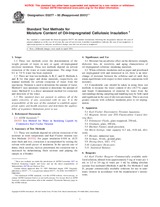Potřebujeme váš souhlas k využití jednotlivých dat, aby se vám mimo jiné mohly ukazovat informace týkající se vašich zájmů. Souhlas udělíte kliknutím na tlačítko „OK“.
ASTM D3277-95(2001)e1
Standard Test Methods for Moisture Content of Oil-Impregnated Cellulosic Insulation (Withdrawn 2010) (Includes all amendments And changes 12/31/2010).
Automaticky přeložený název:
Standardní zkušební metody pro vlhkosti Obsah oleje impregnovaných celulózových Izolace (Withdrawn 2010 )
NORMA vydána dne 15.6.1995
Informace o normě:
Označení normy: ASTM D3277-95(2001)e1
Poznámka: NEPLATNÁ
Datum vydání normy: 15.6.1995
Kód zboží: NS-23116
Počet stran: 4
Přibližná hmotnost: 12 g (0.03 liber)
Země: Americká technická norma
Kategorie: Technické normy ASTM
Anotace textu normy ASTM D3277-95(2001)e1 :
Keywords:
cellulosic, insulating oil, moisture, oil, paper, water, ICS Number Code 29.040.10 (Insulating oils)
Doplňující informace
| Significance and Use | ||
|
Moisture has an adverse effect on the dielectric strength, dielectric loss, dc resistivity, and aging characteristics of oil-impregnated cellulosic insulating materials. When cellulosic insulation such as paper and pressboard are impregnated with and immersed in oil, there is an interchange of moisture between the cellulose and oil until they attain equilibrium with respect to their relative saturations with moisture. Considerable care should be taken in using these test methods to measure the water content of dry (<0.5 %) paper and board. Contamination of material by water from the surroundings during sampling and handling may be both rapid and significant in the case of dry test specimens. This is an even greater concern with cellulose insulation prior to oil impregnation. |
||
| 1. Scope | ||
|
1.1 These test methods cover the determination of the weight percent of water in new or aged, oil-impregnated electrical insulation. These test methods depend on solvent extraction of the water at room temperature. The range from 0.1 to 7.0% water has been explored. 1.2 There are four test methods, A, B, C, and D. Methods A and B for thin paper and dense materials, respectively, are manual methods for solvent extraction of water from the specimens. Titration is used to determine the amount of water. Method C uses automatic titration to determine the amount of water. Method D is a direct automated method for extraction and detection of the water. 1.3 This standard does not purport to address all of the safety concerns, if any, associated with its use. It is the responsibility of the user of this standard to establish appropriate safety and health practices and determine the applicability of regulatory limitations prior to use. |
||
| 2. Referenced Documents | ||
|




 Cookies
Cookies
